
How to grind a wood carving knife blade
Share
Shaping a wood carving knife is one of the most difficult steps of actually making the knife. You need to have steady hands and a very good grinder.
Best belt sander for wood carving knife making
While you can make knives on cheaper 1x30 grinders, a larger and more powerful grinder like a 2x72 makes life a lot easier and features like speed control can help in eliminating excessive heat and burrs in final grinding stages while still providing high material removal rates. Below is a 1x30 I made using an angle grinder for the motor.

The standard 1x30 sold at tool stores has a 1/3rd HP motor and this just really is not enough to remove decent amounts of metal before the motor stalls out.
The same is true of the 4x36, having only a 1/3 or 1/2HP motor stock. The 6x48 is better with a 3/4HP motor stock, but the belt selection for wood carving knife making is very limited. the 6x48 can have the motor easily swapped out to a 2HP 3600RPM motor and this will turn it into a wood carving knife roughing beast with the correct ceramic belts, but it still has very limited selection in belts once you exceed 220 grit and even belts over 120 grit can be difficult to find.
Overall, a customized belt sander with more HP or 2x72 in a 1HP or higher are the only real choices IMO for efficient wood carving knife making. If you are planning on making much larger tools and don't mind a lot of final hand grinding, a 6x48 might suffice but a 2x72 is really king.
Best sanding belts
Good belts are very important too. I prefer Norton Blaze and similar premium brand ceramic belts for initial grinding of wood carving knives due to their wonderful high cutting speed and extremely long life.To get best life and cutting speed use very high surface speeds and high pressures. These belts do not mind being used to round off sharp features and love nothing more then to eat steel as fast as you can feed it in. You can rough a small wood carving knife to shape in under a minute with enough horsepower behind one of these belts. I personally have made over 100 1" to 2" blades on a single belt and only then is it deemed worn out.

Trizact belts for 220 grit and higher up to 2000 grit excel at low pressure grinding and will become quickly grooved/worn out if you use them at high pressures or try to smooth out sharp edges. Trizact belts also cut very cool, especially at lower speeds.

These ceramic and trizact belts may cost 2 to 5 times what you are currently paying for belts but they will last easily 10 times longer and cut faster throughout their entire life then even a slightly worn cheaper belt.
Save cheap belts for woods that gum up and ruin belts. Also consider trying a sandpaper cleaning block to maximize the life of your sandpaper. Just rub the block on your sanding belts with the machine running and 98% of the material clogging them is removed.
As for the process of actually shaping and grinding the wood carving knife, you will want a table or blade rest with adjustable angle to hold a consistent bevel as doing it freehand is exceptionally difficult. Use sharpie marker after 120 grit or so to paint the blade and ensure that you sand off all of the sharpie marker with each progressively finer grit to make sure you get all the scratches out.
Sharpie marker will also help show you exactly where you are grinding on the blade if you are doing it freehand and show you if you are rounding over the bevel.
15 degrees is a good bevel angle to start with if you are doing a single bevel wood carving knife. aim for 8 degrees if you are doing a double bevel knife so the total bevel angle is 16 degrees.
Going much sharper then 15 degrees will generally require a secondary bevel of 15 degrees or more to maintain the cutting edges strength. For very narrow carving knives (under 3/8" wide) a bevel angle of 20 degrees is recommended to keep the knife from being too thin.
If you are grinding on hardened steel and don't plan to re-harden it, you must make sure not to overheat the blade. Use cool cutting belts like trizact or fresh ceramic belts, frequently dunk the blade in water and use a slow speed on your belt sander if you have the option.